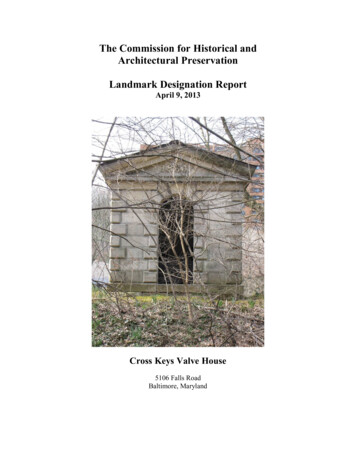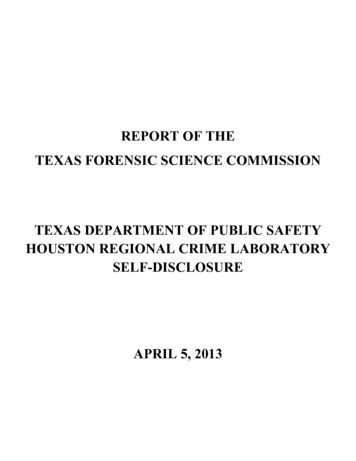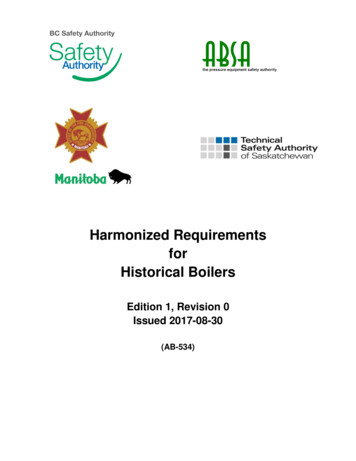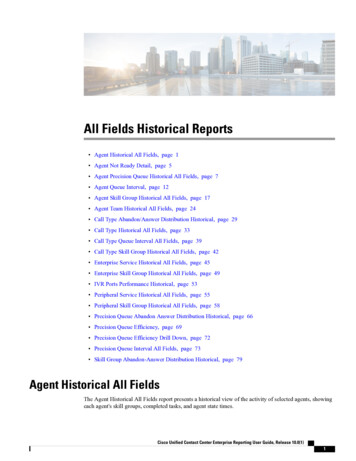
Transcription
The Commission for Historical andArchitectural PreservationLandmark Designation ReportApril 9, 2013Cross Keys Valve House5106 Falls RoadBaltimore, Maryland
Commission for historical & architectural preservationKATHLEEN KOTARBA, Executive DirectorCharles L. Benton, Jr. Building417 East Fayette StreetEighth FloorBaltimore, MD 21202-3416410-396-4866STEPHANIE RAWLINGS-BLAKEMayorTHOMAS J. STOSURDirector
Significance SummaryThe Cross Keys Valve House was one of three stone Classical Revival gatehouses thatserviced Baltimore City’s municipal water system along a conduit that ran from LakeRoland to the Mt. Royal Reservoir. Begun in 1858 and completed in 1862, this gravitypowered conduit system then located in Baltimore County provided the citizens ofBaltimore with safe clean water. It was an engineering marvel when completed, and wasthe city’s first truly public utility. The waterworks was designed by James Slade, CityEngineer for Boston and consulting engineer for the Baltimore Waterworks, and thewaterworks was informed by the best practices of waterworks and engineers in othermajor American cities. The Cross Keys Valve House, completed in 1860, was originallycalled the “Harper Waste Weir”, which described a lower chamber in the valve house thatcollected debris from the water as it rushed through the conduit on its way to the cityboundaries. The Valve House and the conduit over which it sits played a significant rolein the city’s municipal water system, and represents a major engineering feat for the Cityof Baltimore.Property HistoryThis property is located just north of the modern gatehouse entrance of the Village ofCross Keys on the west side of Falls Road. It is comprised of a small Greek Revivalbuilding located on an embankment atop a defunct water conduit. The building andconduit were part of the city’s original waterworks. (See Image 1) The building wasoriginally called “Harper Waste Weir” by the Baltimore City Water Department, buttoday is called the Cross Keys Valve House.1 (See Image 2)The valve house and its related conduit was located on a portion of 25 acres of propertyin Baltimore County condemned by the Mayor and City Council of Baltimore in 1857 foruse for the city’s water works.2 These 25 acres were part of the Oakland estate, whichwas purchased in 1801 by Charles Carroll of Carrollton as a gift for his daughter,Catherine, who was married to Robert Goodloe Harper. The Greek Revival Springhouseat Oakland was designed by Benjamin Latrobe, and today is located on the grounds of theBaltimore Museum of Art and is a Baltimore City Landmark. The estate grew to over 440acres by 1818, and was bound approximately by the Jones Falls to the west, what is nowRoland Avenue to the east, Coldspring Lane to the south, and Northern Parkway to thenorth.3 In 1857, the property was owned by Charlotte Harper. She was paid 14,250 for19.5 acres condemned by the Mayor and City Council, and was later paid 2,500 for anadditional 5.5 acres needed by the city for the conduit.4The valve house was constructed in 1860 over the conduit which ran between SwannLake and Hampden Reservoir. Swann Lake, named for Baltimore Mayor Thomas Swann,is today called Lake Roland, and is located in Robert E. Lee Park in Baltimore County.Hampden Reservoir was filled in and serves as athletic fields for Roosevelt Park inHampden. Construction began on the waterworks began in 1858, and was completedduring the Civil War in 1862. The conduit was a 3-mile-long brick elliptical tunnel with1
an area of almost 25 square feet and a capacity of 3.75 million gallons.5 The conduit waslocated above-ground in an embankment at the site of the valve house, but for much of its3 mile course was located below-ground. (See Images 1 and 2) South of the HampdenReservoir, a pipeline brought the water to the Mount Royal Reservoir, which was locatedadjacent to the Jones Falls north of North Ave, the city boundary. This water systemserviced city residents with clean water that was free from water-borne diseases orpollution. The history of the water works is discussed in depth in the Contextual Historysection of this report.The construction of the conduit line, which required the use of 6 million bricks, theexcavation of three tunnels that equaled a mile long, was completed in only 20 monthsbecause the work was done day and night. The contractors for the conduit line were J.W.Maxwell & Co., J.H. Hoblitzell & Co., and F.C. Crowley.6The building has been called a gate house, valve house, and waste weir, all of which areaccurate terms for its function, and were used somewhat interchangeably in documentsabout the structure. Regardless, this building served an important purpose in thewaterworks system. The building allowed access to the conduit at a midpoint on theconduit, and fifteen feet below the conduit there is a lower chamber called a waste weirthat collected debris. In addition, the waste weir served as an access point for drainingwater from the conduit. A gate clapper opened by hand-operated machinery in thebuilding would shift the flow of water from the conduit to an open stream that ran west tothe Jones Falls.7 This open stream was still used into the 1950s. (See Image 3) Both ofthe gatehouses at the reservoirs also operated gate clappers that opened or closed the flowof water in the conduit.The valve house is architecturally similar to two gatehouses that still exist today at LakeRoland and on the SPCA property in Hampden. These gatehouses were completed in1862 and served to control the flow of water from Lake Roland and the HampdenReservoir.8 These two buildings are slightly larger than the Cross Keys gatehouse andfeature windows, but in design are strikingly alike. These two buildings still exist today,but have been altered to serve new uses. All three were likely designed by James Slade,consulting engineer for the Baltimore City Waterworks. In a letter from Slade to theWater Board in 1858, Slade wrote that “Plans are now making for the Gate House andDam at the Lake. Until these are made, the work cannot be let. When let, the preparationof stone for the Gate House will take some time ” which indicates that Slade eitherdesigned the gatehouses and waste weir himself, or an associate designed them.9In its early history, the exterior of the conduit was examined on a weekly basis by thegatekeepers who lived at Lake Roland and Hampden Reservoir, each inspecting thelength of the conduit from their respective gatehouses to the Harper waste weir. Thegrassy embankment covering the conduit was fenced off, a measure that prevented cattlefrom grazing on the embankment.10 The city-owned land around the conduit was used togrow hay and was rented out for pasture, which provided the Water Department withextra income.11 The 1871 Annual Water Department Report reported on the conditions ofthe water infrastructure, and stated the following about the conduit, which was drained2
annually for repairs and cleaning: "The banks near Cross Keys have received a topdressing of manure. The culverts and fencing are in good order. In October six menpassed through the Conduit, and swept its entire length from Harper's Waste Weir toHampden Reservoir with hickory brooms, a distance of two and a half miles, the wholework is in excellent condition."12 At that time, Cross Keys was an African Americanvillage located approximately a half mile south of the valve house on Falls Road. Only afew homes from this enclave still exist today.13In his Annual Report for 1874, Robert Martin, the Civil Engineer for the WaterDepartment, reported that “I found the Conduit from Lake Roland to the Reservoir asclean as the day it was built. On this occasion, as on previous inspections, no defects ofany kind were seen. I am therefore able to report our main artery as perfect a piece ofwork as the day it was built."14The conduit was used to provide water to the city until 1915, when siltation and diseaseended the use of the water from Lake Roland.15 By that time, the property surroundingthe valve house on the both east and west sides of Falls Road had been owned by theRoland Park Company since the late 1890s, and the Roland Park Country Club’s golfcourse was located adjacent to the conduit line on the west.16 Following the update ofwater infrastructure, the conduit line fell out of maintenance, and the propertysurrounding the valve house became owned by the Roland Park Country Club. In 1963,the Roland Park Country Club sold property to the Rouse Company, which constructedthe Village of Cross Keys.17 Water still runs through the conduit under the valve housebut is no longer part of the city’s water system. In the 1960s, the defunct conduit causedsome flooding in the Village of Cross Keys entrance gatehouse, which lies south of thevalve house on the path of the conduit. The construction of the entrance gatehousedamaged that section of the conduit.18Today, the Cross Keys Valve House is owned by the Cross Keys ManagementCorporation, and managed by Village Management, Inc. Jim Holechek, former residentof Cross Keys Village and author of Baltimore’s Two Cross Keys Villages: One Black.One White, has been the steward of the Cross Keys Valve House for many years. Heraised 9,000 to restore the structure in 2009, and still personally maintains the propertytoday. He has requested the landmark designation of this property.The Cross Keys Valve House is not listed on the National Register of Historic Places, butis certainly eligible for inclusion given that other parts of the same waterworks aredesignated. Lake Roland was designated in 1992 as a National Register Historic Districtsignificant for its architecture and role in Baltimore’s municipal waterworks, serving asan important example in Maryland of a major public engineering work. The lake, dam,and gatehouse are all included in the designation.19 The Hampden Reservoir gatehouse islocated on the property of the Snyder-Carroll House, also known as Evergreen-on-theFalls, which is individually listed on the National Register of Historic Places.3
Contextual HistoryBaltimore’s Water SystemBaltimore has had a water system for almost the entirely of its history. Two years afterBaltimore City was created in 1797, a city council committee recommended laying pipesfor water distribution. In 1800, following an outbreak of yellow fever, a deadly waterborne disease, an act was passed in City Council allowing the Mayor and City Council toadminister a city water supply.20 In 1804, the private Baltimore Water Company wasestablished for the purpose of supplying residents with water, constructing a waterworkson the Jones Falls, installing a system of wooden pipes, and building pumps, springhouses, and fountains. In 1854, the City of Baltimore purchased the Baltimore WaterCompany for 1.35 million, established a water board, and quickly went to workexpanding the waterworks to meet the growing city’s needs for clean, safe water.21Deadly water-borne diseases, such as yellow fever, were common in Baltimore and otherAmerican cities. The distribution of fresh water was imperative for public health and alsoplayed an important step in fostering the city’s growth.The plans for creating the conduit began in 1858 after studying similar water systems andconsulting with engineers in other cities that had similar systems, such as Boston andWashington, D.C.22 The Board also requested surveys and recommendations from severalwater engineers, including James Slade, City Engineer for Boston; Captain ThomasPhiloteos Chiffelle, engineer for the Baltimore Water Works from 1843-1846 and 1852,Baltimore City surveyor, and engineer for national railroads; and Theophilus E. Sickels,formerly with the Boston Water works, and later an engineer for several nationalrailroads.23 The construction of the entire waterworks was overseen by Charles P.Manning, engineer-in-chief.24 James Slade, Boston’s City Engineer, was chosen as theconsulting engineer and designed the plans for the Baltimore City Waterworks.25Officially opened in 1862 after almost ten years of planning and construction.Baltimore’s new water system was the city’s first truly public utility, described as “astupendous feat, placing our great metropolis on the Olympian heights of the ancients andtheir hydraulic genius,” and the classical temples that served as gate houses and wasteweir symbolized this aspiration of ancient infrastructural prowess.26 On January 7, 1862,Acting Mayor Baker addressed the City Council, stating that “ we can now look uponthe whole [works] with satisfaction and pride, knowing that the City of Baltimorepossesses durable water works, furnishing a full and constant supply of pure, wholesomewater, unsurpassed by any other city.”27 It was considered such a tremendous feat,because the water works could supply the city with almost four times the needed amountof water daily, and delivered the water only using gravitational force, without a need forexpensive steam-powered pumps or other equipment that risked breaking down andcutting off the water supply.28 The waterworks project also included the construction ofan extensive network of pipelines in the city, as well as fireplugs and fountains. Thewater works was completed at a cost of 3.5 million, which included the cost ofpurchasing the earlier privately-held waterworks.294
Although the water works officially opened in 1862, by August 1861, some citizens hadalready been enjoying the excellent water for six months. The portions of the project thatremained to be completed were the “ornamental superstructures of the gate-houses of thedam and Hampden reservoir, the gate-keepers cottages, and the new Mount RoyalReservoir.”30 The gate houses at Lake Roland and the Hampden Reservoir (now locatedon the SPCA property) are the same Classical Revival design as the Cross Keys ValveHouse. The Cross Keys Valve House was completed in 1860, and the gate houses werecompleted in 1862.By 1863, over 18,000 households received water.31 The next year, the water works couldsupply four times more water than was needed by the populace, but the city determinedthat it needed to increase its water supply, anticipating greater demand. 32 The Jones Fallwater supply was improved with the Druid Lake, which was the first major earthfill damin the US when it was completed in 1871.33 Later additions include the Western PumpingStation and Western High Service Reservoir, also in Druid Hill Park.Following a severe drought in 1872, the city decided to further expand the city’s watersupply north to the Gunpowder River. The Gunpowder supply was brought into the cityvia Lake Montebello and the now-defunct Clifton Lake. The city’s water supply wasfurther sustained through the construction of other reservoirs and water towers in thenorthern portions of the city, including the Roland Park water tower, which is a BaltimoreCity Landmark.34 The original conduit provided water to the city until 1915, whensiltation and disease ended the use of the water from Lake Roland.35Much of the infrastructure from the original waterworks has been destroyed. TheHampden Reservoir and Mount Royal reservoir have been filled in. The above-groundremnants of the brick conduit between Lake Roland and the now-defunct HampdenReservoir was destroyed by the construction of Cross Keys Village and the Poly/Westernbuilding.36James Slade, Consulting EngineerJames Slade was the consulting engineer for the Baltimore Waterworks and designed theplans for the waterworks.37 The Water Board found him to be competent for this taskbased on “his experience in the construction of works of a similar character” in Boston.38From 1855 to 1862, he was the City Engineer for Boston. During his tenure in thatposition, he extended Boston’s waterworks to the Back Bay district of Boston. He alsoserved as a consulting engineer for the waterworks of other major American cities,including Hartford, Washington, D.C., and Salem.39 He is also credited, along withoriginal architect George Meacham, as a designer for the Boston Public Garden, aNational Historic Landmark.40 Slade was responsible for the design of the Baltimorewaterworks, which likely included the architecture of the gatehouses and valve house.Architectural Description5
The Cross Keys Valve House is an 11’ x 16’ front-gabled stone Classical Revivalbuilding. Located on top of the conduit embankment, it faces east towards Falls Road.The tooled ashlar stone is square cut in regular courses on all elevations. The façade has acentral arched doorway, ornamented with quoining. The doorway features an iron gateddoor. This door was designed by Jim Holechek and wrought in 2009 by Baltimore’soldest ironwork company, G. Krug & Sons. This gate allows visitors to see into thestructure and view the original valve pedestals, clapper, and grates within the building.The exterior of the building features quoins on the building corners and around the archedentrance. The building has a simple cornice, above which the date “1860” is carved intothe pediment under the gable eaves. The building also features a slate roof, which wasreplaced in kind by Jim Holechek in 2009. The other three elevations do not have anyfenestration. On the south, west, and north elevations, a rough-cut stone base is visible.Staff RecommendationsThe property meets CHAP Landmark Designation Standards:B. A Baltimore City Landmark may be a site, structure, landscape, building (or portionthereof), place, work of art, or other object which:1. Is associated with events that have made a significant contribution to the broadpatterns of Baltimore history;3. Embodies the distinctive characteristics of a type, period, or method ofconstruction, or that represents the work of a master, or that possesses highartistic values, or that represent a significant and distinguishable entity whosecomponents may lack individual distinction.4. Has yielded or may be likely to yield information important in Baltimoreprehistory or history.The Cross Keys Valve House was one of three stone Classical Revival gatehouses thatserviced Baltimore City’s municipal water system along a conduit that ran from LakeRoland to the Mt. Royal Reservoir. Begun in 1858 and completed in 1862, this gravitypowered conduit system then located in Baltimore County provided the citizens ofBaltimore with safe clean water. It was an engineering marvel when completed, and wasthe city’s first truly public utility. The waterworks was designed by James Slade, CityEngineer for Boston and consulting engineer for the Baltimore Waterworks, and thewaterworks was informed by the best practices of waterworks and engineers in othermajor American cities. The Cross Keys Valve House, completed in 1860, was originallycalled the “Harper Waste Weir”, which described a lower chamber in the valve house thatcollected debris from the water as it rushed through the conduit on its way to the cityboundaries. The Valve House and the conduit over which it sits played a significant rolein the city’s municipal water system, and represents a major engineering feat for the Cityof Baltimore.6
Locator MapTopographic map depicting the location of the Valve House and the conduit on the parcel.7
Historic MapsImage 1: “A topographical map of the Swann Lake and aqueduct of the Baltimore city water works, 1862”,Augustus Faul. Courtesy of the George Peabody Library, Sheridan Libraries, Johns Hopkins University.Accessible at: http://jhir.library.jhu.edu/handle/1774.2/349668
Image 2: Detail of the Harper Waste Weir in “A topographical map of the Swann Lake and aqueduct of theBaltimore city water works, 1862”, Augustus Faul. Courtesy of the George Peabody Library, SheridanLibraries, Johns Hopkins University. Accessible at: http://jhir.library.jhu.edu/handle/1774.2/349669
Image 3: Detail of 1953 aerial photograph of the Roland Park Golf Course, showing the Valve House andthe stream of “waste” water running its course to the Jones Falls. From “Then and Now: Northwest” pageof Roland Park’s website. Accessible at: sImage 4: Photo titled “Harper's Waste Weir - Roland Supply,” depicting the Cross Keys Valve House onAugust 8, 1912. The purpose of the wooden building is unknown, but may have been used for storage.Courtesy of Ronald Parks, Baltimore City Water Department.10
PhotosView from Falls Road of the Cross Keys Valve House, located on the embankment over the defunctconduit.Detain of the datestone.View of the Valve House from the north.11
View of Valve House from the south. The building in the forefront is the gate house for the Cross Keyscommunity.The interior is not the subject of this designation; however, it retains a high degree of integrity.12
Photos of other Gatehouses built for the Baltimore WaterworksFaçade of Lake Roland Gatehouse, built 1861, located in Robert E. Lee Park in Baltimore County.The Lake Roland Gatehouse is adjacent to the dam built for the waterworks.Façade of Hampden Reservoir Gatehouse, built 1861, located on the property of the SPCA adjacent to theparking.13
Today, the Hampden Reservoir Gatehouse is used by the SPCA as a Spay and Neuter Clinic.1“A topographical map of the Swann Lake and aqueduct of the Baltimore city water works, 1862”,Augustus Faul. Courtesy of the George Peabody Library, Sheridan Libraries, Johns Hopkins University.Accessible at: �Water Department- Harper, Mrs. C.C. property bounded by John Cockey B.B. Chamberlain RuralMills”, Baltimore City Archives, Water Supply Records, Administrative Files, 1857, BRG 25-1-2-5-20,HRS # 430; “Water Department- Harper, Mrs. C.C. bounded by Falls Turnpike, William Stevenson”,Baltimore City Archives, Water Supply Records, Administrative Files, 1857, BRG 25-1-2-5-21, HRS #431.3Jim Holechek, Baltimore’s Two Cross Keys Villages: One Black. One White. (New York: iUniverse, Inc.2003), pg. xi-xii.4“Water Department- Condemnation of Land, damages awarded Conduit Line” Baltimore City Archives,Water Supply Records, Administrative Files, 1857, BRG 25-1-2-2-12, HRS # 352; “Water DepartmentHarper, Mrs. C.C. bounded by Falls Turnpike, William Stevenson”; “Water Department- Condemnation ofProperty- Reservoir, property crossed by right of way” Baltimore City Archives, Water Supply Records,Administrative Files, 1858, BRG 25-1-2-7-20, HRS # 605The Mayor’s Message and Reports of the City Officers, Made to the City Council of Baltimore, for theYear 1877 (Baltimore, MD: John Cox, 1878), pg. 439. Digital copy available at the Internet Archive.6“Baltimore City Water Supply: The City Water Works--Their Rise And Progress The” The Sun (18371986); Aug 25, 1869; ProQuest Historical Newspapers: Baltimore Sun, The (1837-1986), pg. 17Jim Holechek “Cross Keys Historical Valve House” On file with CHAP.8“The New Water Works--Report of the Chief Engineer”, The Sun (1837-1986); Aug 16, 1861; ProQuestHistorical Newspapers: Baltimore Sun, The (1837-1986), pg. 19“Water Department- Correspondence- Reservoir, enlargement of same and other” Baltimore CityArchives, Water Supply Records, Administrative Files, 1858, BRG 25-1-2-9-3, HRS # 10310The Mayor’s Message and Reports of the City Officers, Made to the City Council of Baltimore, for theYear 1877, pg. 439.11The Mayor’s Message and Reports of the City Officers, Made to the City Council of Baltimore, for theYear 1888, Volume II (Baltimore, MD: John Cox, 1889), pg. 1340. Digital copy available at the InternetArchive.12Reports of the City Officers, Made to the City Council of Baltimore, for the Year 1871 (Baltimore, MD:John Cox, 1872), pg. 313. Digital copy available at the Internet Archive.13Jim Holechek, Baltimore’s Two Cross Keys Villages: One Black. One White. (New York: iUniverse, Inc.2003)14The Mayor’s Message and Reports of the City Officers, Made to the City Council of Baltimore, for theYear 1874 (Baltimore, MD: John Cox, 1875), pg. 405. Digital copy available at the Internet Archive.14
15Jim Holechek, Baltimore’s Two Cross Keys Villages: One Black. One White, pg. 133.Frank P L Somerville “Plans For New Community Near Roland Park Revealed”, The Sun (1837-1987);Oct 28, 1962; ProQuest Historical Newspapers: Baltimore Sun, The (1837-1987), pg. M4617Frank P L Somerville; Jim Holechek, Baltimore’s Two Cross Keys Villages: One Black. One White.18Jim Holechek, Baltimore’s Two Cross Keys Villages: One Black. One White, pg. 133.19“Lake Roland Historic District, BA-1274”, Maryland Historical Trust DID 1106&CROWD Towson&COUNTY Baltimore%20County&MAP NRMapBA.html&FROM NRCrowdList.aspx?COUNTY Baltimore%20County20“How City Got Water: An Interesting History Given By Former Mayor .”, The Sun (1837-1987); Oct10, 1904; ProQuest Historical Newspapers: Baltimore Sun, The (1837-1987), pg. 821The Story of Baltimore’s Water Supply, (City of Baltimore Department of Public Works, Bureau ofWater and Waste Water, 1981), pgs. 1-3.22“Reports of the Joint Standing Committee Upon the Water Question: Report” The Sun (1837-1986); Sep4, 1855; ProQuest Historical Newspapers: Baltimore Sun, The (1837-1986), pg. 123“The Water Question: Report Upon a Supply of Water for the City of Baltimore Examinations” The Sun(1837-1986); Sep 22, 1854; ProQuest Historical Newspapers: Baltimore Sun, The (1837-1986), pg. 1;“Water Commission: Important Report” The Sun (1837-1986); Jun 17, 1857; ProQuest HistoricalNewspapers: Baltimore Sun, The (1837-1986), pg. 1; “Chiffelle Bio” S.J. Martenet and Co. Inc. History ofthe Firm, 2009. http://www.martenet.com/history/Chiffellebio.html; G. L. Vose and Thomas Doane,“Memoir of Theophilus E. Sickels” Journal of the Association of Engineering Societies, Vol 6. November1886 – December 1887, (New York: The Board of Managers of the Association of Engineering Societies,n.d.), pg. 233. Accessible as a Google book.24“Baltimore City Water Supply: The City Water Works--Their Rise And Progress The”25“Water Commission: Important Report”, The Sun (1837-1986); Jun 17, 1857; ProQuest HistoricalNewspapers: Baltimore Sun, The (1837-1986), pg. 126quoted in Louis F. Gore “Baltimore’s first public utility”, Baltimore Engineer, February, 1976: 8-11; pg.8 and 11.27Charles J Baker, “Mayor’s Message”, The Sun (1837-1986); Jan 7, 1862; ProQuest HistoricalNewspapers: Baltimore Sun, The (1837-1986), pg. 128“Local Matters”, The Sun (1837-1986); May 15, 1862; ProQuest Historical Newspapers: Baltimore Sun,The (1837-1986), pg. 129“Local Matters”, The Sun (1837-1986); Feb 13, 1862; ProQuest Historical Newspapers: Baltimore Sun,The (1837-1986), pg. 430“The New Water Works--Report of the Chief Engineer”31“Local Matters”, The Sun (1837-1986); Jan 27, 1863; ProQuest Historical Newspapers: Baltimore Sun,The (1837-1986), pg. 132“City Affairs Message of Mayor Chapman” The Sun (1837-1986); Jan 13, 1864; ProQuest HistoricalNewspapers: Baltimore Sun, The (1837-1986), pg. 133Gore, pg. 11.34“How City Got Water: An Interesting History Given By Former Mayor .”35Jim Holechek, Baltimore’s Two Cross Keys Villages: One Black. One White, pg. 133.36Gustave J. Requardt, “Informal History of Baltimore City Water System,” The Baltimore Engineer, May1967: 4-5.37“Local Matters”, The Sun (1837-1987); Jul 30, 1857; ProQuest Historical Newspapers: Baltimore Sun,The (1837-1987), pg. 138“Local Mattes”, The Sun (1837-1987); Dec 11, 1857; ProQuest Historical Newspapers: Baltimore Sun,The (1837-1987), pg. 139Massachusetts Charitable Mechanic Association, Annals of the Massachusetts Charitable MechanicAssociation, 1795-1892, (Boston: Press of Rockwell and Churchhill, 1892), pg. 348.40“Boston Public Garden” The Cultural Landscape Foundation, http://tclf.org/landscapes/boston-publicgarden1615
serviced Baltimore City’s municipal water system along a conduit that ran from Lake Roland to the Mt. Royal Reservoir. Begun in 1858 and completed in 1862, this gravity-powered conduit system then located in Baltimore County provided the citizens of Baltimore with safe clean wa











